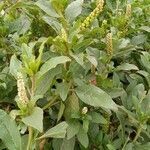Glabrous, spreading or ± erect subshrub to c. 2 m tall, with numerous white raphides on stems and lower surface of lvs. Stems softly woody towards base, often reddish. Petioles to 2.5 cm long, moderately thick, often reddish. Lamina 4-15-(20) × 1.5-5 cm, elliptic or elliptic-ovate; base cuneate to attenuate; apex acute or mucronate. Racemes erect, to c. 7 cm long at maximum flowering, to c. 11 cm long at fruiting; peduncles and very short pedicels ± granular, becoming crimson at fruiting. Fls ☿, dense. Bracts 3-4 mm long, linear-lanceolate to subulate; bracteoles much smaller. Perianth 5-7 mm diam.; tepals accrescent, 2-3 mm long, broad-ovate, imbricate, whitish or pale greenish at first, becoming pink to crimson at fruiting. Stamens 8-(10), slightly < perianth; anthers white. Ovary (7)-8-carpellate, green with numerous white raphides. Fr. c. 8 mm diam. when fresh, depressed globose, with 8 very shallow and often inconspicuous grooves (prominent in dried specimens), shining black, very succulent with dark red juice. Seed 2-2.5 mm diam., subglobose, glossy black.
Herb to 2 m high, semi-succulent above, woody below; stems slightly tuberculate. Leaves petiolate, elliptic or lanceolate, acute or acuminate; lamina to 21 cm long and 9 cm wide; base acute; petiole to 5 cm long. Racemes dense, 7–16 cm long; flowers bisexual; pedicels to 3 mm long. Tepals ovate, 2.5–4 mm long, white to red, persistent. Stamens mostly 8, inserted on outer edge of disc. Carpels mostly 8; styles recurved, c. 0.5 mm long, persistent. Berry depressed-globose, furrowed between the seeds, c. 0.7 mm diam., black. Seeds ovoid, compressed, c. 2 mm long, shining black.
Branched herb, 40-60 cm high; stem angular. Leaves oblong-lanceolate or ovate-lanceolate from an acute base, gradually narrowed towards the apex or acuminate, 6-15 by ¼-6 cm; petiole 1-3 cm. Adult raceme 8-25 cm long (¾-3 cm peduncle included), dense; rachis more or less densely papillate or almost smooth. Pedicels during anthesis 1-2 mm, under adult fruit 2-3 mm. Tepals ovate, varying from rather acute to rather obtuse, during anthesis pink, 2½-3 mm long, under the fruit 3-4 mm. Styles 7-9, usually 8. Fruit with 8(7-9) longitudinal furrows. Seeds ± 2 mm long.
Plants to 2 m. Leaves: petiole 0.5-3 cm; blade lanceolate to elliptic, to 22 × 7.5 cm, base obtuse to attenuate, apex acute to acute-acuminate, sometimes mucronate. Inflorescences axil-lary or terminal spikes or spikelike, equaling or shorter than subtending leaves, to 14 cm; peduncle to 3 cm; pedicel absent or to 2 mm. Flowers: sepals 5, white to pinkish or reddish, oblong to ovate, subequal, 2-3 × 1.2-2 mm; stamens (7-)8-10, in 1 whorl; carpels 7-10, connate; ovary 7-10-loculed. Berries greenish, 4.5-6 mm diam. Seeds black, lenticular, 2 mm, shiny.
Bushy, ± succulent herb, up to 2 m high. Leaves narrowly elliptic to elliptic-lanceolate, base attenuate to obtuse, apex acute to acuminate; petioles decurrent, up to 25 mm long. Inflorescences axillary or terminal spikes, up to 140 mm long. Flowers bisexual, white, sessile or pedicels up to 1 mm long. Sepals 5, Sub-Equal, ± ovate, spreading at anthesis. Stamens 8-10 in one whorl. Carpels 7-10. Flowering time Sept.-Apr. Fruit a berry, 7-10-ribbed, styles remain clustered inside, depression at apex of fruit, green-black when ripe.
An erect herb. It grows 2 m high. It has a well developed taproot. The stems are spreading and branching. They are red coloured. The leaves are bright green and 20 cm long. The leaves change from bright green to reddish-purple in autumn. The flowers are pale green or white. They occur close together in upright spikes. The flowers have 8 stamens. The fruit are green berries which become deep purplish-black. Their juice is red-purple.
Herb, up to 2 m high. Leaves alternate; blade narrowly to broadly elliptic, up to 150 x 80 mm; petioles up to 20 mm long. Flowers: in a terminal or lateral, leaf-opposed raceme; carpels completely united; perianth white to yellowish green; Nov.-Apr. Fruit a berry with 7-10 ribs, purplish black when ripe.
Subsucculent, tuberous shrublet to 2 m. Leaves lanceolate, sometimes denticulate and slightly revolute. Flowers in cylindrical, subspicate racemes, greenish but persistent and red in fruit. Fruit in stiffly erect racemes, fleshy, depressed-subglobose when fresh, glossy black.
Leaves: lamina 3.5–13.5 × 1–5 cm., narrowly elliptic to elliptic-lanceolate, base cuneate, decurrent and usually oblique, apex acute-acuminate with often recurved mucronate tip, glabrous; petioles 0.3–2.0 cm. long, glabrous.
Herb, up to 2 m high. Inflorescence a spike. Flowers perfect. Carpels completely united. Fruit a berry, 7-10-ribbed, purplish black when ripe. Flowers white.
Fruits (6) 7–8 (10) lobed, 5–8 mm. in diam., depressed globose, remains of styles clustered in apical depression, glabrous, black when ripe.
Inflorescences terminal or lateral, leaf-opposed racemes, 4–14 cm. long, rhachis sparsely and crisply pubescent to glabrescent.
Ovary of (6) 7–8 (10) united carpels, 1.5–2 mm. in diam., 0.75–1 mm. tall, glabrous; styles c. 0.25–0.5 mm. long, linear.
Stamens 8 in one whorl; filaments 1–2 mm. long, filiform, united at base; anthers c. 0.5 × 0.25 mm., oblong elliptic.
Sepals 5, 2–3 × 1–1.5 mm., ovate-elliptic, apex rounded to acute, spreading at anthesis, glabrous.
Flowers hermaphrodite, white to yellowish green, subsessile or with pedicels up to 1.5 mm. long.
Bracteoles c. 1 mm. long, lanceolate to subulate, glabrous.
Seeds 2–3 mm. in diam., discoidal; testa shiny black.
Bushy herb or subshrub, 1–2 m. tall, semi-succulent.
Bracts 1.5–2 mm. long, lanceolate, glabrous.
Disk very thin, almost non-existent.
Stems glabrous, sometimes trailing.

